At this pace, tariffs will raise an additional $230 billion in corporate taxes a year. US nonfinancial corporate profits spiked to $3 trillion a year.
By Wolf Richter for WOLF STREET.
The amount in tariffs collected by the government in July rose to $28 billion, from $26.6 billion in June, $22.2 billion in May, $15.6 billion in April, and $8.2 billion in March, when collections from the new tariffs began.
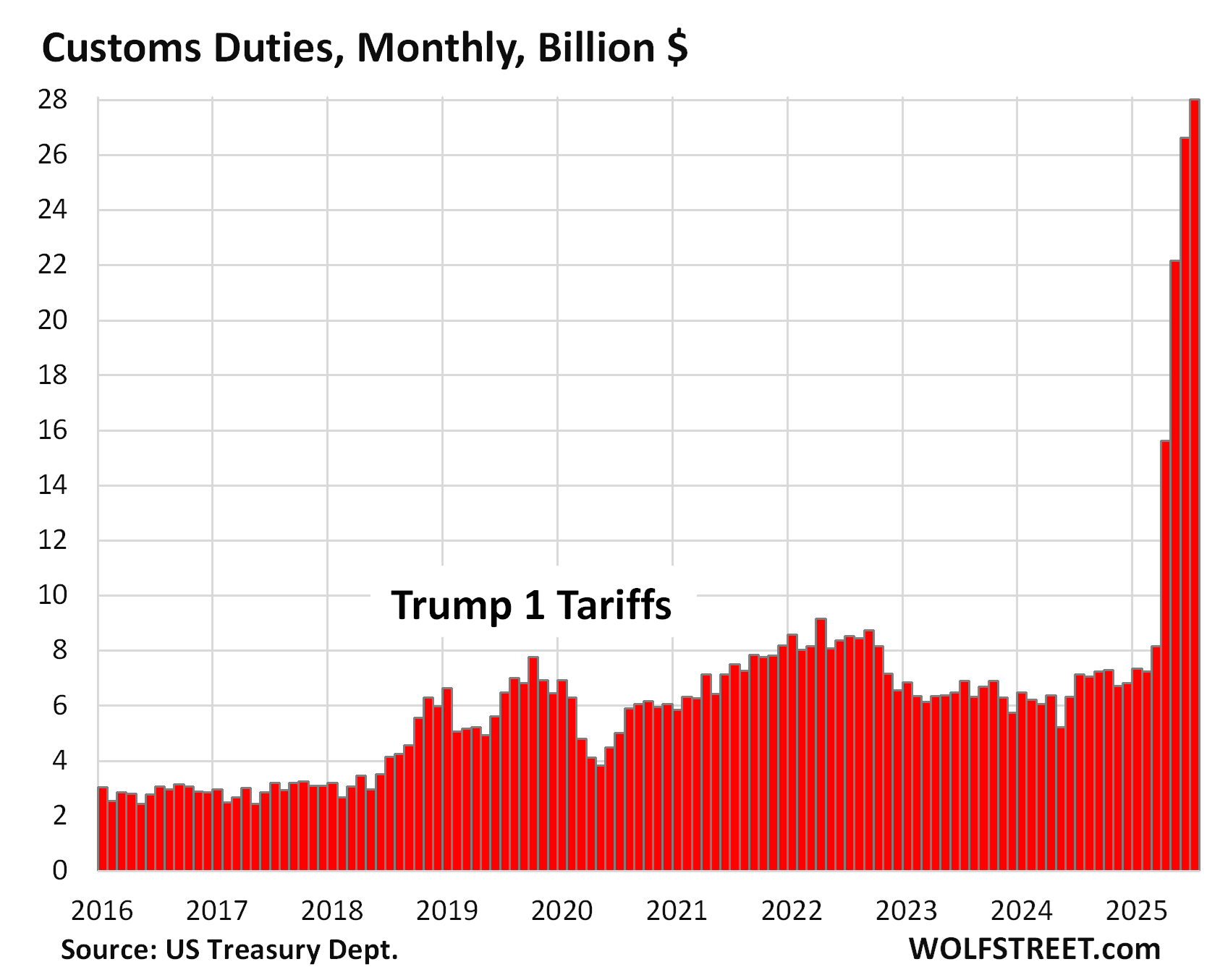
In the three months from May through July, $77 billion in tariffs were collected. If collections continue at this pace, $308 billion in tariffs will be collected in the 12-month period.
In the fiscal year ended September 2024, the government collected $77 billion in tariffs. So the new tariffs would bring in an additional $230 billion in revenues.
That $230 billion in additional tax receipts may not sound like a lot within the fiscal fiasco that the US government has constructed.
But corporate income taxes collected in the last fiscal year fell to $366 billion (from $393 billion in the prior fiscal year). And this additional $230 billion from tariffs would raise the amount in taxes that companies pay by around 60%!
The tariff data is from the Monthly Treasury Statement (MTS), except for July, which is from the Daily Treasury Statement (DTS) for July 31, released on Friday. The DTS lists “customs duties” and “certain excise taxes” combined as one line item. The MTS – the July edition will be released on August 12 – separates “customs duties” from “excise taxes.” The difference between the DTS figure and the MTS figure reflects the excise taxes and has averaged $1.6 billion a month for the past 12 months. So the July figure here is the DTS amount of $29.6 billion minus $1.6 billion in estimated excise taxes.
Tariffs are taxes paid by businesses on goods that are imported, on their cost of the imported good. Whether or not businesses can pass them on to consumers to push up consumer price inflation in goods depends on market conditions – specifically on consumers.
If consumers refuse to pay whatever, if they shop around and compare, and buy from a competitor or forgo purchases whose price has jumped, then companies cannot pass on the tariffs because if they raise prices, their sales will fall, and they will lose market share.
Which is what is currently happening in new vehicle sales. After automakers and dealers jacked up prices during the pandemic – the CPI for new vehicles soared by 21% in two years — prices hit a ceiling. It’s a tough market. New vehicles have become very expensive. There is not a lot of demand at these prices. Automakers and dealers have to offer deals to make sales. It’s a market-share battle.
Some models have 65% or 70% or more in US content, and have far less tariff exposure than imported vehicles with near-zero US content, or vehicles assembled in the USA with mostly imported parts that have little US content.
GM imports vehicles from Mexico, South Korea, China, and Canada after having globalized its production when it emerged from bankruptcy with the help of a government bailout. It said in its earnings warning that it expects tariffs to cost it $5 billion this year. But no biggie. It will continue to incinerate billions of dollars in cash on share buybacks.
Ford raised its estimate for its costs of the tariffs for this year to $2 billion. They have to compete with models from Tesla, Honda, Toyota, Hyundai-Kia, etc. that are assembled in the USA with much higher US content.
For automakers and dealers, the problem now is that consumers are no longer willing to pay whatever. The 21% price spike in 2021 and 2022, when automakers and dealers amassed big-fat record profits, was only possible because consumers, loaded with free money, were willing to pay whatever, including the odious addendum stickers that appeared at that time. But that was then, and this is now. The free money is gone, and consumers are no longer willing to pay whatever.
The Consumer Price Index for new vehicles for June declined for the third month in a row, seasonally adjusted (red line). Not seasonally adjusted, it eased for the second month in a row (blue line), and was about flat year-over-year. Here are the details of our CPI analysis.
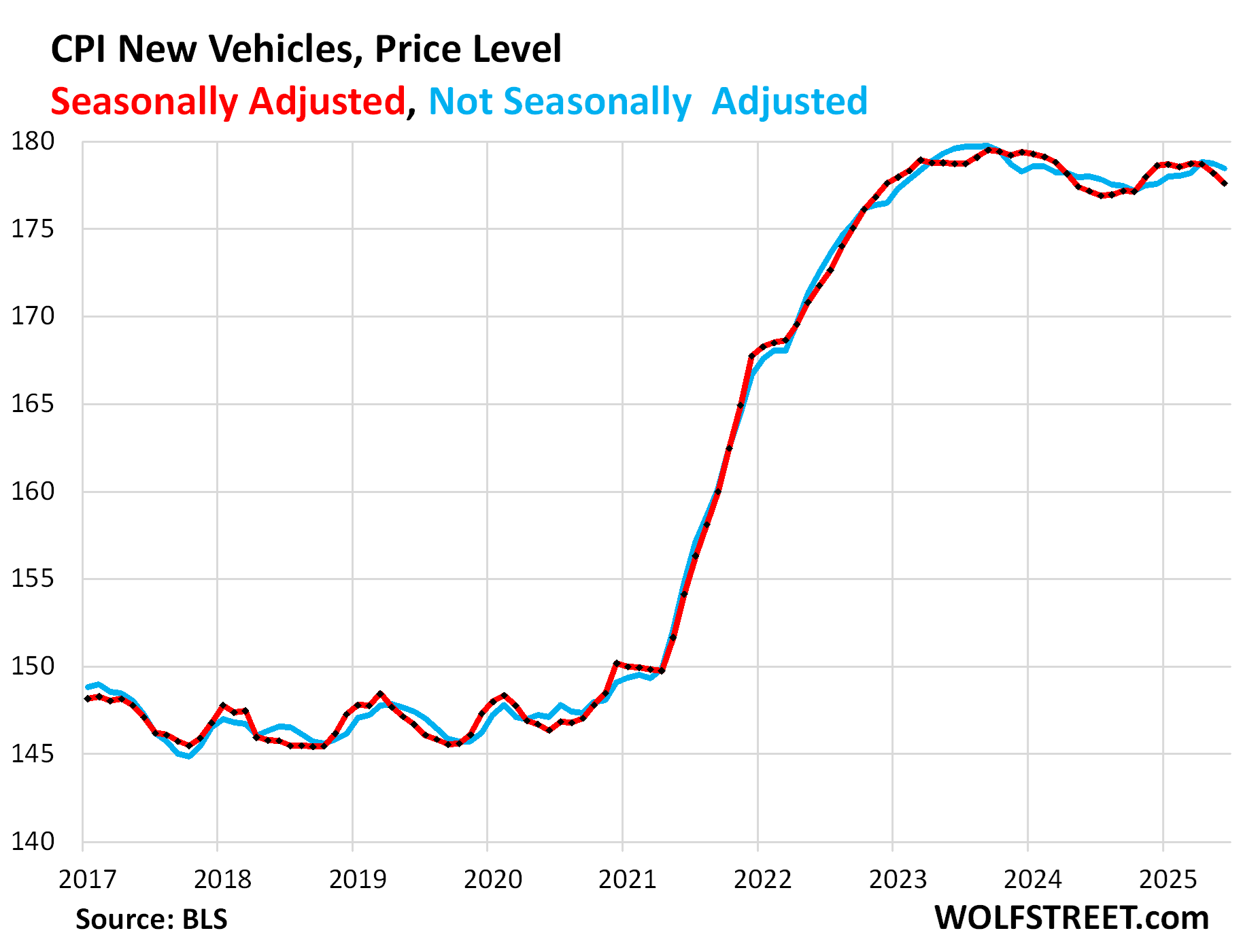
Companies always try to raise prices and get the maximum price possible. They use “dynamic pricing” online where prices can change from minute to minute, based on various factors, including what is known about the buyer. They hike prices and then offer “discounts,” they’ll do anything they can to make comparison-shopping harder. There is nothing new about that, and tariffs won’t change it. Companies will always try to get the maximum price possible.
What keeps price increases limited, in normal times, are vigilant consumers that are not willing to pay whatever. That’s how a free market operates.
The free-money era of 2020-2022 destroyed that balance, and inflation and retailer profits – see charts further down – exploded.
Durable goods prices overall barely budged in June from May, and year-over-year were up just 0.6%.
The durable goods CPI had exploded by 25% in two years from mid-2020 to mid-2022 during the free-money era. Then prices declined for two years (negative CPI). But from September 2024, prices inched up again through January, and since then have been roughly flat.
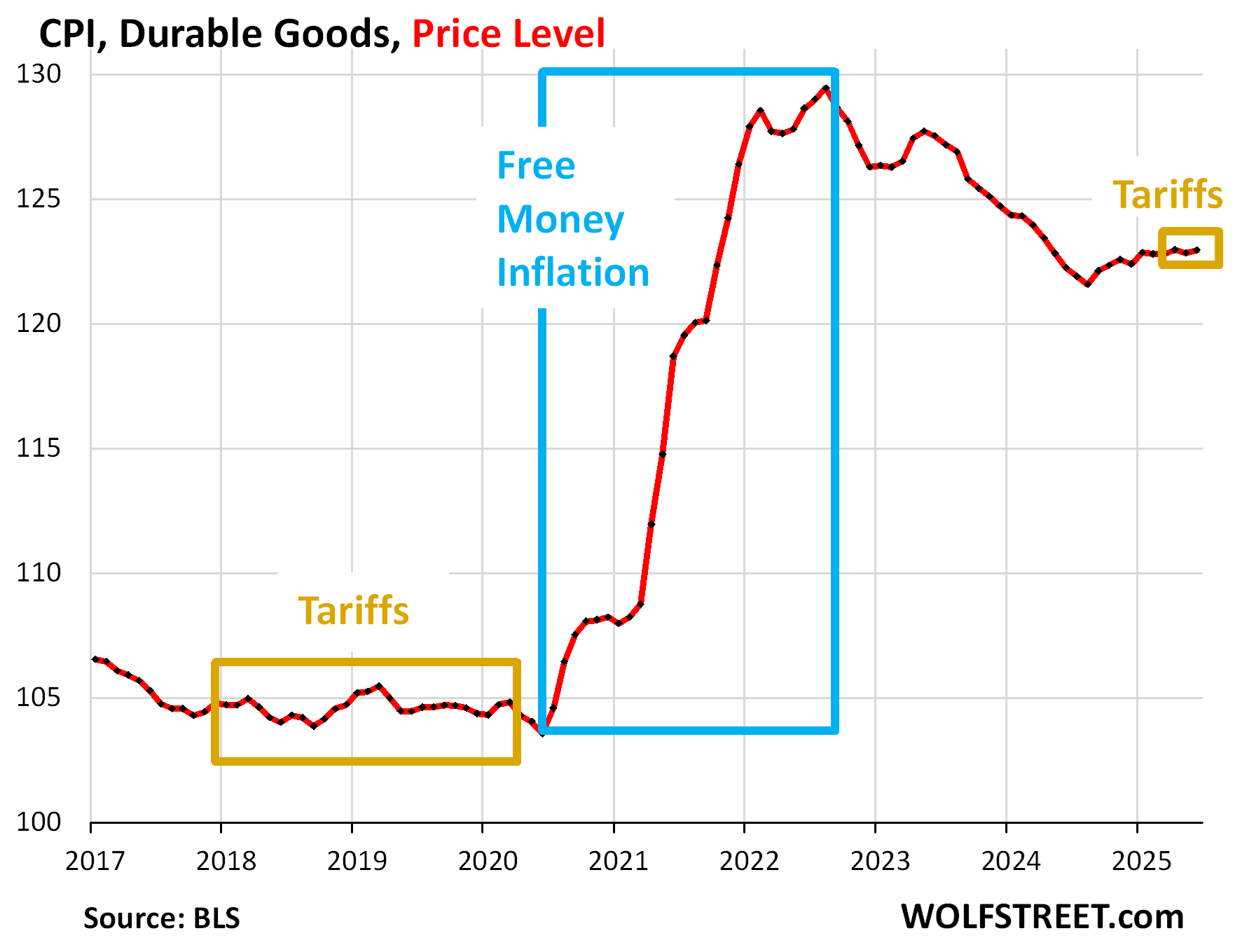
Apparel and footwear are also heavily exposed to tariffs. The CPI for apparel and footwear rose by 0.4% month-to-month in June but only undid the equal drop in May, with no price change over the two-month period. Year-over-year, the CPI for apparel and footwear declined by 0.5%. Consumers are in no mood to pay whatever.
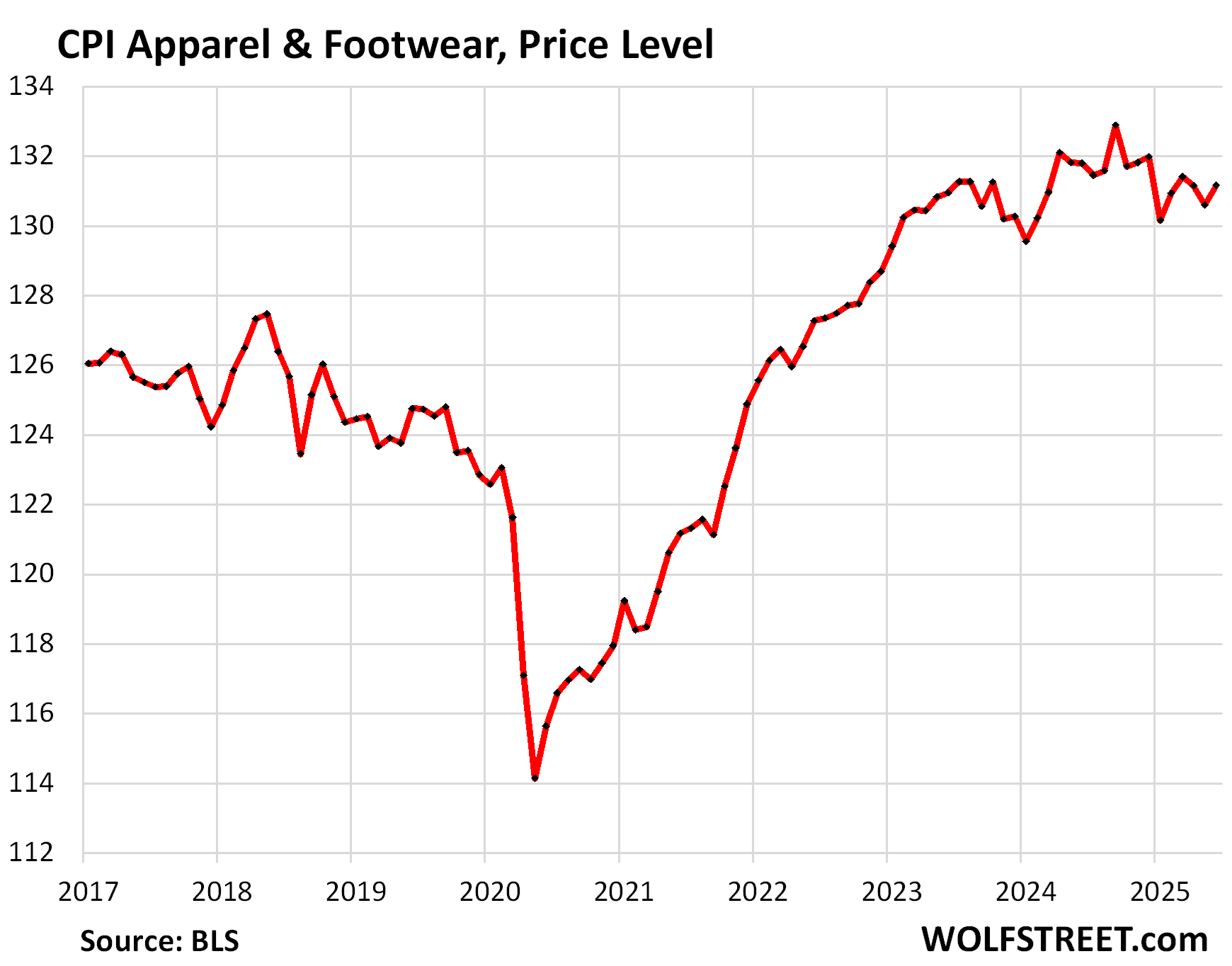
Some prices of goods rose in recent months while others declined. Companies are always trying to raise prices. It’s up to the buyers to walk away. That’s part of a free market.
If a company’s sales crater and its market share shrinks because it raised prices and enough ticked-off consumers shifted purchases around, then that’s an expensive lesson.
So this is a very tough situation for companies to be in. To what extent tariffs can be passed on to consumers is unpredictable and depends on market conditions – on the consumers.
Corporate profits are an essential factor in the equation of tariffs.
Pre-tax profits at ecommerce and brick-and-mortar retailers of all sizes exploded during the pandemic because consumers were willing to pay whatever, and retailers jacked up their prices by far more than their costs went up, and consumers paid those prices, and that’s where part of the inflation came from.
In Q1 2025, pre-tax profits at retailers were up by 138% from Q1 2020. Here is our discussion and charts of corporate profits by industry.
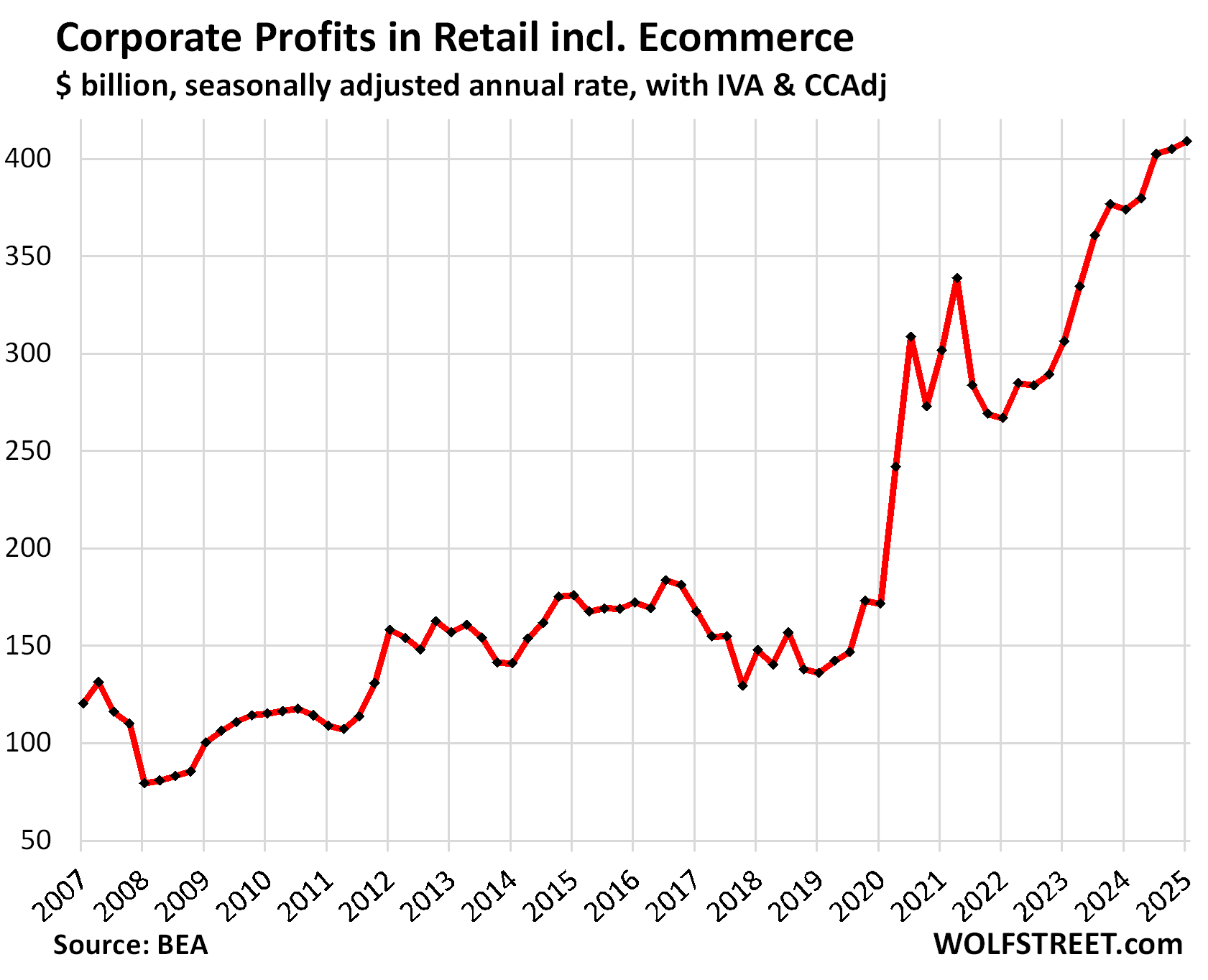
Pretax profits of all nonfinancial domestic industries rose to nearly $3 trillion annual rate in Q1 2025, up by 122% since Q1 2020. They include retailers, wholesalers, manufacturers, companies in information, companies in business, professional, and scientific services, etc.
The high-inflation era came from prices being jacked up, and profits exploded because companies raised prices far faster than their costs increased. Tariffs are now beginning to reverse some of those profits.
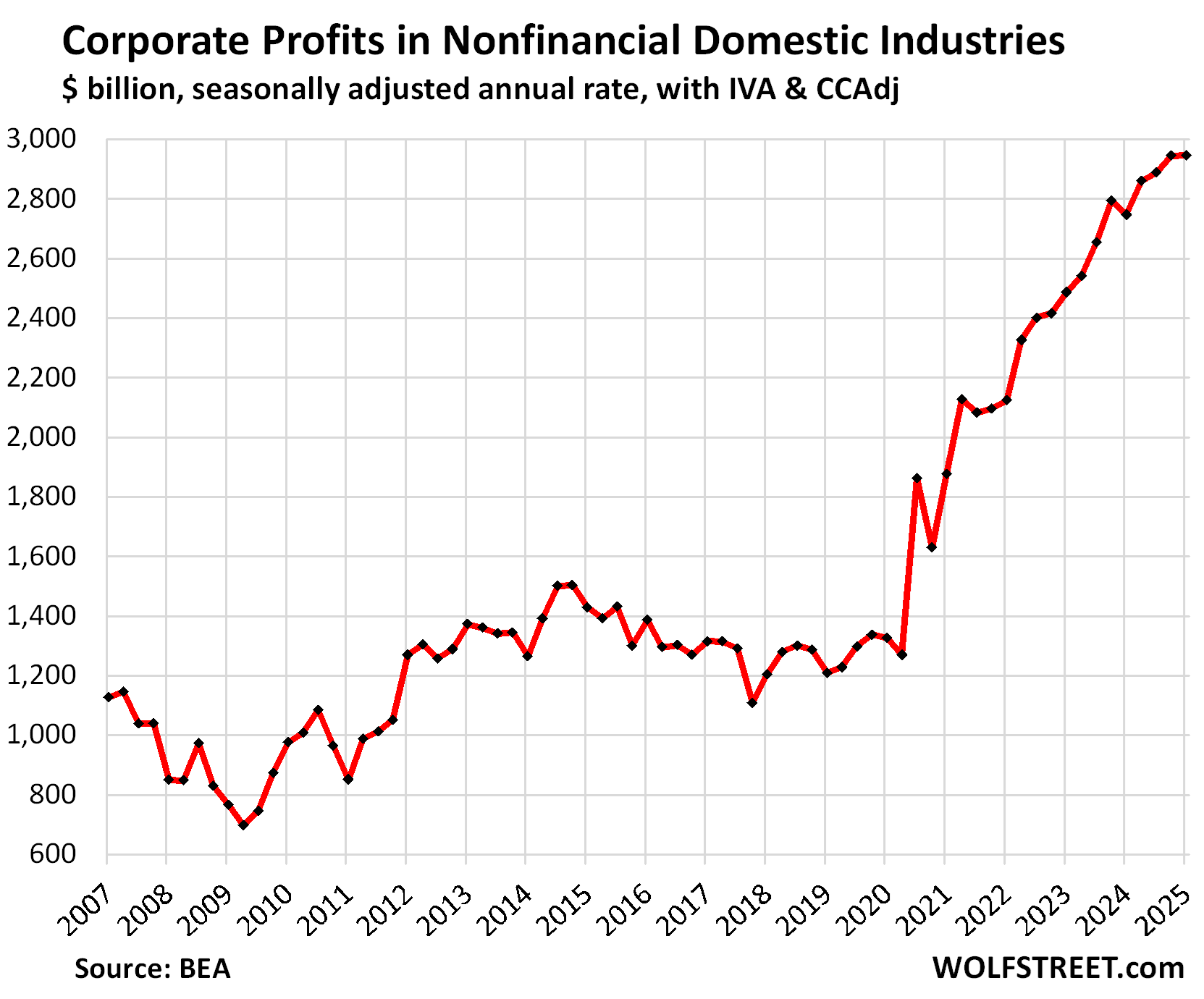
The primary goal of tariffs is to change the math in corporate investment decisions so that enough manufacturing gets developed in the US over the years to achieve a roughly balanced trade with the rest of the world.
Many big companies have already announced new manufacturing projects in the US. A factory construction boom took off in 2022, and over the past two years, spending on factory construction about tripled to a range of $18 billion to $20 billion a month, just for the buildings, not including the costs of the industrial robots and equipment that can dwarf the costs of the building.
These efforts take years, from initial decision to mass-production. Even shifting production to an existing plant in the US takes time.
So there is a long way to go before the trade deficit (negative net exports) in goods and services of over $1 trillion a year – the result of four decades of reckless globalization by Corporate America and government encouragement – turns into balanced trade.
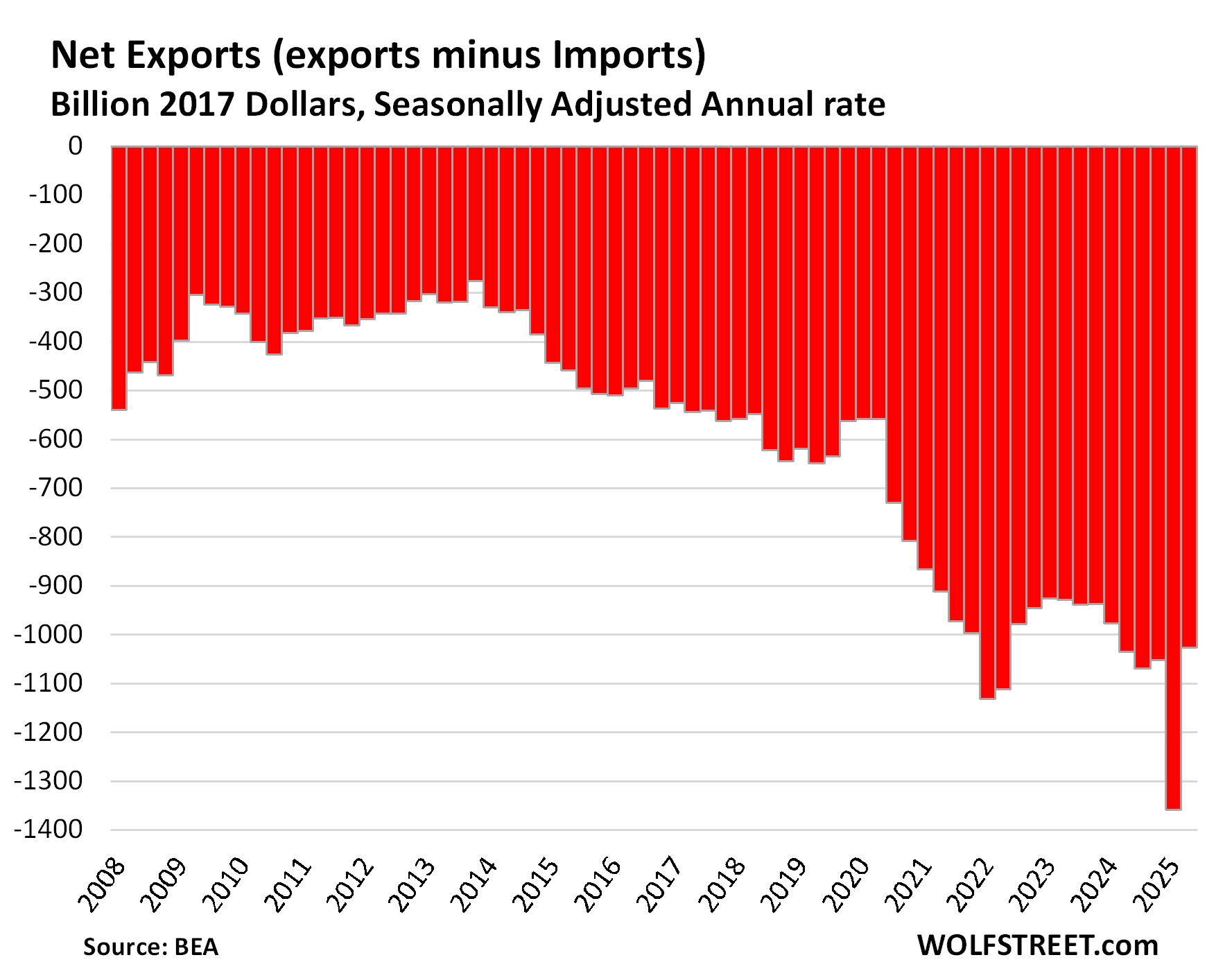
Enjoy reading WOLF STREET and want to support it? You can donate. I appreciate it immensely. Click on the mug to find out how:
![]()


Impact of auto tariff reductions to 15pc? Will that reduce tariff collection significantly?
What will reduce tariff collections significantly is more production in the US of autos and components. And that is the primary goal.
The consumer is not only hit by tariffs but also by the 10% devaluation in the USD which adds another 10% to the price of imports.
I have a feeling fewer imports will be bought, meaning tariff income to the feds will be less, and whatever cost is absorbed by business will also reduce business taxes to the various governments (federal and state).
Nice experiment. Let’s see what the results are on inflation and the deficit in a year from now.
Companies pay little income taxes. Total corporate pretax profits were about $4 trillion in 2024, and they paid $366 billion in taxes in the US. So now you can add $230 billion to the taxes that companies pay in the US, and it’s still low.
The article discusses all this in detail.
So, the company that can provide a domestic product at a competitive price and profit does not have to fear the tariffs? It’s only a tax on those who are dependent on importing.
Such a domestic company would have to fear the tariffs being reduced or eliminated, because tariffs protect domestic producers from foreign competition. That’s why tariffs are a protectionist policy position.
Tariffs are also a tax on the consumer, who might prefer buying cheaper goods imported from places that have lower production costs than domestic producers. That’s the position of globalization advocates. Protecting producers from competition means less competition among producers, which is generally a loss for consumers.
For a given product, tariffs generally benefit domestic producers and hurt consumers and importers, assuming the good could be produced cheaper elsewhere.
However, anti-globalization (protectionism) advocates would probably argue that higher prices are worth paying because part of what you’re paying for is local economic production. Ironically, that has been an argument on the left and fringe left for decades, through ideas like buy local, small is beautiful, local currencies, the velocity of money, etc.
“Such a domestic company would have to fear the tariffs being reduced or eliminated, because tariffs protect domestic producers from foreign competition.”
This is somewhat offset by the initial capital costs (the building of the factory) being already paid. That’ll be part of the math in deciding whether to shift production or not.
Yes! That’s true! We’ve heard “buy local” so many times over the years. It’s basically saying, forego saving money on cheap foreign goods and support the business in your community that employs your neighbors and pays taxes. But ironically, the same people now scream about the tariffs.
Also, we need to remember that just as companies don’t always pass the tariff cost onto the consumer (like Wolf said), they didn’t always pass the savings of importing ultra cheap stuff to the consumer during the free-money Covid years. In other words, they raised prices before tariffs and weren’t trying to lower prices for consumers. Companies only look out for themselves.
I’d settle for American companies not based in Dublin, Grand Cayman, or some other BS. Or maybe Disney not whacking Americans (early) from training their foreign-born replacements for the same job a number of years back…
So, for me, while I don’t care either way about the tariffs nor the corporate profits, I get sick and tired of all these scammy practices going on that are just simple BS.
If the tariffs are the mechanisms that work to put an end to this crap, and happen to make companies that are doing an end-around on corporate taxes, actually pay up, then awesome. And no, I’m not a bleeding heart lib or socialist shmoe… Just an average Gen-X dude that’s calling some BS out. Like the article mentioned- if they have cash for share buybacks, then they have cash to burn… Or pay more in tariffs.
No. This is very simplistic and headlines-based view of economy.
1/ there are different kinds of tariffs, and different goal tariffs. Short term tariffs are heavy-handed and have little to do with economy — they are a political tool to force an opponent to implement certain policy you desire. Long term tariffs differ by goal: some are designed to simply avoid competition (bad), others — to level the playing field, yet others — force local production. Let’s talk the last two.
2/ Leveling the playing field. See, competition is never fare. Say, Canadian aluminum or lumber. Is Canadian lumber cheaper/more competitive because Canadians (fine people, btw) are simply better, smarter, more disciplined, etc — smarter competitors — than fat and lazy USers? Maybe. But also maybe because Canadian producer is pumped up by the Canadian socialist (more interventionist) government. In my mind, Canada to US is what Russia is to EU — raw materials and energy. These industries are known as “strategic industries” and government can’t let them fail (like US can’t let banks fail). So they have levers to pull (any, or all, or any combination): subsidized healthcare, low/free interest loans, softer taxation/environmental regimes, favored labor protection regulations, and so on. Now let me ask again — are you sure Canadian aluminum producers are more competitive, or simply more propped? The answer is — neither of us knows. But what we do know, is that mining aluminum builds infrastructure that can be shared to mine for rare earths. In fact, mining for rare earths on its own is prohibitively expensive, and there’s a reason why China owns pretty much all of it. Consumer will pay less short term, but inevitably pay more long term, once local competition is gone.
2/ Reshoring. Manufacturing is a backbone of any robust economy. Services are great, but the backbone is still production. There’s a reason why China manufacturing is ~40% of GDP and US is ~8%. Globalists said that US will design things and someone will produce or designs. As usual: “sounds great — doesn’t work”. Turns out, people who actually make things, are good at improving them, and are just as smart as US (of not smarter) to design more and better things. Net result — all of production and design moved there, and the best people in US can do — talk social issues, which does not help to fix bridges, etc. Things got so bad, that we couldn’t produce masks during pandemic — that’s an eye opener.
3/ Tariffs are tools. Wield them carefully — you are rebalancing economy and trade, fixing social and mental issues, etc. Misuse/overuse them — and suddenly everything looks like a nail — you hurt consumers and suffocate trade. Historically, greedy C suite was on zero-tariff policy (maximizes short term profit), so there’s little fear of overdoing tariffs (requires a lot of political will to resist C suite and globalists).
4/ Rebalancing trade and economy requires blanket tariffs. If you do targeted tariffs — corporations work around them: you tariff Mexico cars? Companies route Chinese cars through Canada or Belgium. They will assemble EVs where you want but the magic sauce (and all the complexity) is inside the battery pack, etc. Tariffs have to be full bore, across the entire economic perimeter.
My personal take — what happened is nothing short of amazing. Economically — I’m very excited for the next 4, but much better 8 or 12 years (will vote for the same economic policy).
Too Afraid Totell,
To me the idea that other countries are propping up their industries is mostly Western thinking. It isn’t that it isn’t happening, simply that those countries recognize either through ownership or support it is good for their society. I love to see countries that nationalize, much to Americas dislike and sometimes followed by coups or sanctions, as the collective value of things like mining and oil should be collectively owned and benefit society as a whole, not a few multinational corporations and their shareholders.
In short, there is nothing wrong with societies in investing collectively in itself, but the West seems to believe privatization is the only option. Finland is an example of a country that has struck a balance although backsliding in some areas now.
Dude: you don’t “mine” aluminum, you mine bauxite and it’s not a found mineral in Canada in enough quantities to mine commercially. Canada buys bauxite from several foreign entities.
So much for infrastructure building with aluminum. Bauxite and electricity (lots of it) make aluminum.
Canada has aluminum smelters that employ 30,000+ people in various provinces. The U.S. has four aluminum smelters in operation too.
Is there any accountability mechanism for disclosing where the collected tariff money is being spent?
Better question:
Is there any accountability mechanism for disclosing where _all tax money_ is being spent?
The answer is “resounding no”. If there was accountability – a.i.d. staff would not be just fired, 99% of them would be jailed.
Money is fungible. If you think the casino money is financing the school like they claim, then you are too gullible.
Where’s it being spent? Did you miss the big beautiful bill? This pays for a fraction of that. The government still has a massive deficit that is only increasing with that bill, it’s just falling into the widening black hole that is US debt.
The way the tariff rates bounce around on the whim of one DC Celebrity, there is no way of really figuring in advance what the tax being collected will amount to.
My guess is that tariffs are just a distraction.
My guess…you have TDS….lol…
Distraction from what exactly? Truly curious question.
H.F.T.c. The scandal your cult hero has been trying to distract from was his good buddy Epstein. Now he is even adding nuclear subs to the distraction. Seems desperate to me.
The important fact to remember is this…
The money is going to the Government, and its coming from People and Businesses.
Good thing? It is a benefit to one side and a strain on the other.
My understanding is that the tarriffs the US collects go into the TGA (Treasury General Account). The TGA is used to pay for US spending and has an accounting framework with specific categories i.e. Social Security, interest on debt etc. It has an accounting category called the general fund also. This is where the tarriffs flow.
I find it interesting the putative 3 trillion dollars in debt the CBO used for continuing the Trump tax cuts does not account for the roughly 3 trillion in tarrif collection over the same time period. At some level this gives me a glimmer of hope that we are not as screwed by the debt of this nation as I believed. Nonetheless the uniparty will sniff this out and will find some way to spend it.
Fundamentally Trump is raising taxes. Yes some will fall on corporations and be absorbed given the exorbitant profits they have enjoyed. But other will be absorbed by the consumer.
As a mechanism of raising revenue it is the least dirty shirt in the laundry in my opinion.
As always my conclusions welcome any feedback. This forum has some incredibly talented participants-hence I hesitate to even comment…especially when there is a Wolf lurking about.
My understanding is that the tariffs are put in place to onshore domestic manufacturing. If this is effective, then tariff revenue will not stay elevated as you seem to suggest.
It will take quite a while for domestic industry to replace the tariffed imports.
Stephen Hren
That is the hope, and that would be a huge accomplishment, and it would massively boost tax receipts.
Manufacturing and its secondary and tertiary activities in the US generate a large amount in tax receipts at all levels of governments. It would be far greater than the tax receipts lost to shifting production to the US. Manufacturing and its secondary and tertiary activities have a massive impact on the economy, unlike services.
It seems like there are several generations here that have no idea about manufacturing because they have lost all contact with it?
…ah, the ‘unknown knowns’, the ‘unknown unknowns’, and an apparent need to frequently ‘reinvent the wheel’ (…occasionally-seen in ‘the study of history’…). Though the Great ‘Murican Consumer ‘is always right’, is it tough enough to doff its sailor’s cap and seriously-‘buyers strike’ to get its desired low-price stability while understanding it’s in competition with the concomitant reality of a greatly-increased world population and ITS improving living-standard cost-demands on the spacecraft’s ability to supply?…
may we all find a better day.
“It seems like there are several generations here that have no idea about manufacturing because they have lost all contact with it?”
I find this statement quite true and seriously saddening to me. This country was built on manufacturing and I made my career out of it in heavy industry (metals). I finished in oil & gas production operations. My Dad and his siblings did the same.
Most young people I meet now haven’t got a clue how something is made and what raw materials and processes it takes to make that happen. NOT THE FOGGIEST IDEA!
Most of them can’t even open the hood on their car or change a tire!
But they do know how to use their iPhone and bitch about the U.S.
Years of the Free Trade is Good Consensus will do that to people.
There was a reason why organized labor and domestic manufacturers freaked out over NAFTA and then let China into the WTO. They knew it would crush domestic manufacturing, and it did. This was a bipartisan effort, for the political scorekeepers.
Whether it was “good” for “the country” is a complicated question, often colored by personal interests. I would say it was roughly good for the college educated class (cheaper goods), and bad for the non-college educated class (lower wages). Geopolitically, it did not lead to a rise in democracy. Arguably, it did help out a lot of poorer nations, including China and Vietnam. Good?
But rather than go back to the 1960s, our trade policy is being rolled back to flirting with the 1800s, then settling around the 1940s-1950s, unilaterally, whimsimsically, and secretively. “Experts” are just guessing at this point.
Google will tell you Clinton was forced into signing the China Relations ACT by a Republican congress. But I remember he was a major proponent because he thought the US could help shape China. This was probably the biggest political and economic folly the US has made in the last 50 years.
I’m seeing the headlines about 50% coffee tariffs followed by photos and tweets implying that it will lead to a 50% increase in the cost of the coffee bought at Starbucks and similar places. Do people realize how little of the cost of those coffee-flavored beverages are attributed to coffee? The best article I could find says that between 3 and 4% of the company’s revenue is spent on beans. Even if that goes up by 50% for tariffs, that would still mean between 4.5 and 6%, which is an almost negligible part of your daily morning beverage. Something tells me that a 10% hike is more about padding the bottom line than Trump’s tariffs.
You’re right, poorly written articles. But the vast majority of coffee purchased is also not from Starbucks and is going to rise in price. I get mine in bulk from Costco, it’ll pretty much be a straight pass-through to me as a consumer.
Although saying that, it won’t be 50% in the longer run as they’ll just switch away from Brazilian vendors. More likely 15-25%. Still, I don’t usually like having to pay an extra 20% tax on goods I purchase.
Buy American coffee from Puerto Rico.
1. Coffee futures prices started spiking in 2021 and QUADROUPLED through January 2025. BEFORE TRAIFFS. Coffee prices have since the PLUNGED 33%.
People and media need to quit pushing ignorant bullshit about tariffs and coffee — or tariffs in general.
(BTW, Hawaiian coffee is awesome too. Coffee production has started in southern California).
https://tradingeconomics.com/commodity/coffee
Do you actually think Puerto Rico can grow enough coffee to meet all of US demand? Puerto Rico grows 3 million pounds of coffee a year. A lot, but just shy of the 3.5 billion that the US consumers a year. You’re just about a 1000 times off, good job.
Really my assumption of 15-25% was assuming countries like Columbia and Nicaragua could absorb the impact, but that is already pretty optimistic.
@wolf. Lived in Hawaii for 20 years and still go back to visit family on the reg. Hawaiian coffee can be great if your taste buds love burnt dark roasted coffee. But it’s pretty expensive vs other names because you’re paying for the “Hawaii” part. Even more if it’s from Ka’u or Kona. There’s a reason people aren’t buying $50/coffee from there on the reg.
Taking about reshoring coffee production in usa and it’s territories kind of proves free trader’s arguments. Ideally, production of goods should happen in areas where there is a comparative advantage to do the economic activity.
Wolf makes a good point that a bigger influence on coffee prices is more likely to be climate change. Importers will work hard on playing the tariff game. If things get really bad, the tariff hawks will chicken out. Unwise to get between addicts and their fix. Especially as Brazil’s tariff rate is mostly to do some political adventuring.
IMO: Starbucks and others are not coffee companies. They are milk and sugar companies with a hint of coffee.
How true! I ordered a back coffee last time I was in one and they kid behind the counter looked confused. Seems like that was not a menu item, and it was terrible coffee.
Just unfollow those sources. Doing so doesn’t limit your exposure to news, only slop created to generate ad revenue or paint a terrible picture. On some cases raw ignorance but all those are best left to die on the vine if possible.
The amount of braindead BS in the media is astounding. Fire all these people that produce this stupid manipulative clickbait and replace them with AI. AI cannot do worse than that. But maybe they already got fired and this stuff is already generated by AI.
…but won’t THOSE ‘journalists’ simply join the corps already at the Fed???
may we all find a better day.
They could if they have a PhD in something or other….
“The primary goal of tariffs is to change the math in corporate investment decisions so that enough manufacturing gets developed in the US over the years to achieve a roughly balanced trade with the rest of the world.”
How do corporations get assurance that the tariffs will remain in place? I could build a doorknob factory in the U.S., hire and train workers, and start making doorknobs, because the price of foreign-made doorknobs has gone through the roof due to tariffs. But as soon as those tariffs are dropped, consumers will start buying foreign-made doorknobs again. So, I have to go to my shareholders and convince them that the U.S. government will keep the doorknob tariffs in place indefinitely, or at least long enough so that I can break even on my new doorknob factory? This seems like a hard sell, since if the tariffs can be applied by the wave of a wand (a “deal”) by the POTUS, they can be dropped just as easily. Do the tariffs consist of actual contractual trade agreements between countries that have some stability, or are they simply something that the POTUS could change overnight (since it seems that tariffs are ultimately determined by the POTUS alone)? If the latter, how can corporations make long-term decisions, based on what one person in the U.S. government decides autocratically?
There are many advantages to manufacturing in the US, including lead times, transportation costs, not losing your IP, avoiding supply chain risks (remember Covid?), etc.
The disadvantages are related to US taxes in that companies, when they produce something overseas, can route the invoices through a low-tax jurisdiction, such as Ireland, take their profits there, and then import the product to the US at a cost that generates nearly no profit in the US, and therefore no income taxes. The Senate did an investigation into Apple’s practices in 2013, and that’s exactly how Apple is doing it. Tariffs change that math.
Biden left most of Trump’s tariffs in place.
That said, not everything will be manufactured in the US, obviously. There will be trade for sure. The idea is to bring trade into balance, not to end trade.
Alternatively, companies simply transfer ownership of their IP to a foreign subsidiary. Items are manufactured in the US, shipped to US distributors, sold in the US – and the profits are routed by creative (and legal) accounting tricks to a low-tax foreign subsidiary as “license fees”. Look at the profits showing up on, say, Apple’s shareholder reports versus thise on it’s US tax returns.
The CIT ruled that these tariffs are illegal. At oral argument, the Federal Circuit recently exhibited a fair amount of skepticism about their legality. I’m wondering if the Wolfosphere has an opinion on what’s likely to happen when the Supreme Court gets ahold of this issue.
IMO, extreme indeterminacy, sorry. The Court of Appeals is relying heavily on precedent, and this SCOTUS has shown a strong willingness lately to jettison that. Also last term it handed the presidency increased powers. The IEEPA legislation came from an era of the legislature seeking to contain presidential prerogatives. But the pendulum lately seems opposite, especially in SCOTUS. That could mean increased latitude for Trump to interpret what is an emergency, and to fashion a response. I think Roberts is very focused, however, on the scope of presidential power, and carefully walking along a line on that, one side and the other, so it should be a heavily reasoned opinion.
…hm. the general understanding and acceptance of the Eleventh Commandment is in obvious and admittedly-confused, retreat. It’s remaining corollary, the sanctity and application of Barnum’s Dictum (i.e.: “…never give a sucker an even break…”) now comes to the fore of the dealing art…
may we all find a better day.
Does the deficit in goods balance the surplus in services? Or is the net trade still negative? What are the risks of a country that loses it’s goods export market in the USA turning around and banning services imports from the USA? Like a boosted form of global digital tax?
This is the deficit in total trade. The goods deficit is much bigger. Services has a small surplus (a big part of services exports are foreign tourists spending in the US). So that chart shows the net of the goods deficit and services surplus.
For a detailed discussion of goods and services trade click on this link:
https://wolfstreet.com/2025/02/05/trade-deficit-in-goods-worsens-to-all-time-worst-in-2024-small-surplus-in-services-improves-overall-trade-deficit-worsens-by-17/
While too many variables will likely exist, a 5 years retrospective would be interesting on this. Did we achieve, or make progress, on the goals, and was this the right approach? As the global South grows in consumer power, albeit slowly, and as demographics take more hold here while also being 4.5% of global population. Reality is something needed to be tried but my sense is you can’t halt the overall global trajectory, especially while having inconsistent policies(increase revenues with tariffs, but massively spend more money with new legislation). Still not convinced that a lot of the investment promised with follow through as good publicity for them and to the administration. Yes, call me skeptical but see you in 2030 to discuss.
This may come off as ignorant but it is what it is and I don’t know what I don’t know.
Wouldn’t a chart of corporate profits showing net margins be a better example? Also, e-commerce is growing in general and even more so in lieu of the pandemic; so it would make sense that profits represented in dollars would balloon. Wouldn’t large retailers like Walmart and Amazon also skew that data vs. smaller companies that are unable to pass on the tariffs?
“If collections continue at this pace, $308 billion in tariffs will be collected in the 12-month period.” Excellent! At this pace we can pay down the national debt in 120 yrs! Just to give ya an idea bout how big our debt is…